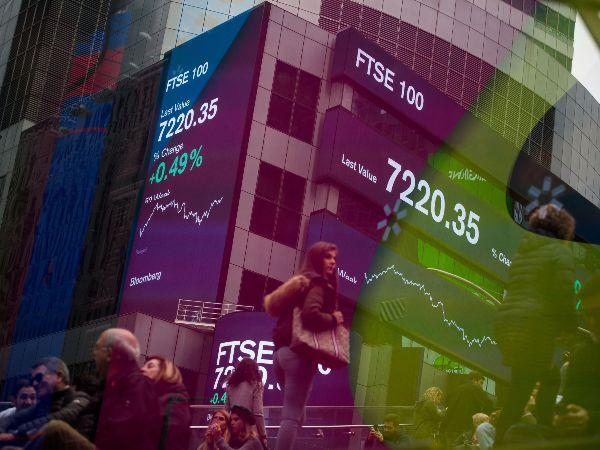FTSE 100 oil majors: where next for BP and Shell?
Both FTSE 100 oil titans, BP and Shell, have recorded record annual profits for 2022. Climate strategies and windfall taxes remain on the agenda for 2023.
 Source: Bloomberg
Source: Bloomberg
As the FTSE 100 breaks fresh record highs amid a gallop to the symbolic 8,000-point watermark, two corporations are having an outsized influence on the UK’s premier index's continued success compared to international peers.
BP and Shell's share prices are up 36% and 24% over the past year respectively, and both have posted record annual profits for 2022.
FTSE 100: BP and Shell full-year earnings at a glance
Shell’s FY22 adjusted earnings came in at $39.9 billion, a huge rise over the previous record of $28.4 billion in 2008, and more than double the $19.29 billion earnt in 2021. The company has announced a $4 billion share buyback program to be completed by early May, and a 15% dividend share increase for the fourth quarter.
Meanwhile, BP’s underlying replacement cost profit — a proxy for net profit — came in at a record $27.7 billion for the year, and again more than double the $12.8 billion of 2021. The FTSE 100 oil major has announced its own $2.75 billion share buyback and upped its dividend by 10%.
Further, while Brent Crude has now fallen to circa $85/barrel from its peak, this elevated pricing is likely to stay as long as the war continues. For context, the US Energy Information Administration currently projects that Brent will average $83.10 through 2023 and $77.57 through 2024. Bar a severe global recession leading to demand destruction, or another economic shock from an unknown quarter, BP’s so-called ‘cash machine’ seems set to continue, at least over the near term.
Energy transition or windfall taxation?
These outsized profits have caught the ire of much of the UK public, who are facing record energy bills both domestically and across businesses of all sizes up and down the country. Arguably, these gains are simply the windfalls of war — profits made through increased demand as the pandemic ended and Ukraine War began, rather than through sound business strategy.
Of course, some investors may point out that current windfall taxes are already steep, and that there was no state-sponsored bailout when Brent went negative in April 2020. However, there are now two schools of thought regarding where this increased income — and therefore where both BP and Shell’s share prices — will go through 2023 and beyond.
The first idea is that windfall taxes must increase. But for perspective, the tax rate on profits derived from the North Sea is set at 35%, while oil and gas firms also pay a 30% corporation tax rate. Including the 10% supplementary charge, this brings the current tax rate on both BP and Shell up to 75%, though there are deductions available for investment, or for offsetting losses such as the costs of decommissioning North Sea oil platforms.
What’s often missing from the debate is that less than 10% of BP’s profits come from the UK; at Shell this figure is only 5%. While the ‘Energy Profits Levy’ cost BP $700 million in 2022, an windfall tax increase would be unlikely to generate much more income for HMRC, and may in fact be counterintuitive as it acts as a deterrent on investment. Indeed, leading independent producer Harbour Energy has blamed the tax for its plan to shun new oil and gas licencing in the region and to cut hundreds of jobs.
The alternative school of thought — and the one FTSE 100 constituents BP and Shell both encourage — is that these additional profits will be used to speed up the energy transition. BP’s annual energy outlook sees the share of fossil fuels as a primary source of energy falling from 80% in 2019 to between 20% and 55% by 2050, while renewables will grow from 10% to between 35% and 65% in the same period.
Both BP and Shell are targeting becoming net-zero companies by 2050, but both have been accused of watering down their climate commitments as the pressure to deliver high shareholder returns outweighs ESG concerns. Given the increased dividends and share buybacks, it’s hard to dismiss this argument.
And for perspective, 11 Shell directors are now being personally sued at the high court by environmental lawyers ClientEarth — supported by a large group of pension funds and other institutional investors — in a novel test case under the UK Companies Act for failing to properly prepare the company for the net zero transition.
Meanwhile, despite BP CEO Bernard Looney arguing that the FTSE 100 company is ‘helping provide the energy the world needs’ while investing in the transition, the firm has significantly scaled back prior plans to cut carbon emissions by reducing its oil and gas output. Previously, the oil major had committed to lowering emissions by 35-40% by 2030, but its updated strategy is for a 20-30% cut with the saved cash going into increased investment in fossil fuel development.
This leaves both BP and Shell shares with an unenviable catch-22: to keep at-odds ESG and profit-focused investors on side, while simultaneously balancing the risks and rewards of uncertain taxation policy.
Trade and invest in over 17,000 UK, US and global shares from zero commission with us, the UK’s No.1 trading provider.*
Learn more about trading or investing in shares with us, or open an account to get started today.



.jpeg.98f0cfe51803b4af23bc6b06b29ba6ff.jpeg)
0 Comments
Recommended Comments
There are no comments to display.
Create an account or sign in to comment
You need to be a member in order to leave a comment
Create an account
Sign up for a new account in our community. It's easy!
Register a new accountSign in
Already have an account? Sign in here.
Sign In Now